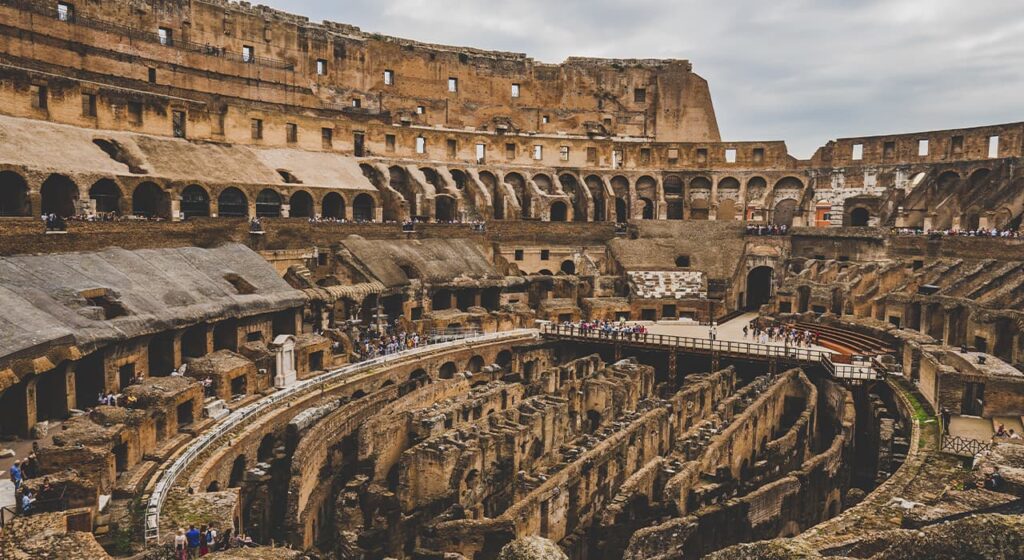
Design of amphitheaters
Amphitheaters were not always a separate building. Only large and wealthy cities could afford it. Many amphitheaters were temporary buildings. Sometimes, in order to save money, the amphitheater was built on a hillside or deepened into the ground, pouring earthen ramparts under the stands from the soil excavated during the excavation. The slope of the hill or embankment was given the necessary shape and rows of seats were cut out in it, which were then only lined with stone. This significantly saved time, material and labor costs, in particular, due to the fact that it was not necessary to build a powerful foundation necessary for a separate stone amphitheater.
Over time, the appearance of the amphitheaters changed. For example, the external staircases that provided access to the public in early amphitheaters such as the amphitheater in Pompeii were later removed inside, and the facade was decorated with arches, semi-columns and statues. Such are the amphitheaters built approximately from the turn of the old and new eras and later – the Colosseum, the amphitheaters in El Jem, Verona, Pula, Nimes and others.
The arena (from the Latin “arena” – “sand”) of the amphitheater was an elliptical surface sprinkled with sand with approximate dimensions of 65–80´35–50 m. , however, they were necessary for the solemn procession (pomp) and the persecution of animals (venatio). In most amphitheaters, the arena was not located directly on the ground, but on a special wooden platform. Under the arena, there was a whole complex of separate rooms and passages, called the hypogeum.There were warehouses with scenery and weapons, dressing rooms, wild animals and their attendants were housed, there were also elevators on which the participants of the performances were lifted for their more spectacular appearance in the arena (see below for the design of elevators using the example of the Colosseum). In addition to the underground hypogeum complex, behind the high wall of the podium there was a number of rooms, some of which had access to the arena. This gallery, going around the arena, was called the punishment cell. Usually the punishment cell carried only an additional function, but in amphitheaters without an underground floor, the punishment cell served as a hypogeum.
Caligula and Nero at magnificent games showed a colored arena – “red lead and mountain greens” were poured over the sand, as a result of which the arena acquired a red or green color. These colors reflected the passions of the two parties of fans of chariot races in the circus – “Red” and “Green”.
Sometimes for performances on a mythological theme, animal hunts or theatrical executions in the arena, a landscape was erected from mountains, trees and buildings. In some amphitheaters, including the Colosseum before the construction of the hypogeum, special pools were made under the arena, designed to be filled with water. During most of the usual performances, they were covered with plank flooring. Pools of water were intended to represent mythological subjects and to hunt sea and river “monsters” (crocodiles and hippos). Sometimes they also held mini-naumachias with the participation of small boats and ship models.However, the arena was too small for real naumachia, and they were arranged on natural or artificial lakes.
To protect spectators from wild animals and gladiators, the arena was surrounded by a high wall (from 2.2 to 4 m). However, some animals from the cat family could take this height. Therefore, during performances with them, the height of the podium wall was additionally increased with a stretched net or poles with a net stretched between them were installed in the arena at a distance of 2 to 4 m in front of the wall. The latter option was preferable: on the one hand, the animals could not even approach the wall of the podium, and on the other, there was no possibility that any action would take place right next to the wall of the podium in an area invisible to some.
To protect against bad weather or the bright sun, a mirmillon awning was stretched over the stands of the amphitheater. Velarius was a strip of fabric attached to special masts. Depending on the position of the sun, it was moved, involving professional sailors for this.
The seats in the amphitheater (loka, kavea) were organized in such a way as to emphasize the social hierarchy of society. For the first time, senators received seats separate from the people at the games of 194 BC. Then it gave rise to a lot of talk: some supported such a division, others fiercely criticized, accusing the senators of excessive pride. In the end, the side of the latter was taken by Scipio Africanus himself, who proposed this innovation. However